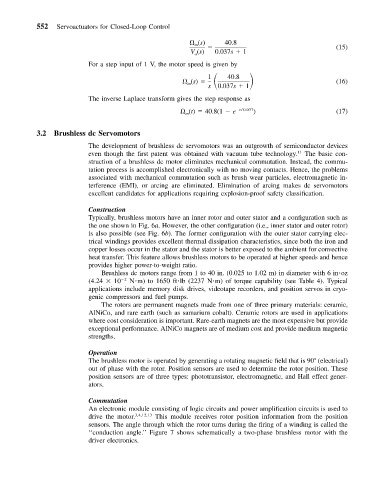Page 561 - Mechanical Engineers' Handbook (Volume 2)
P. 561
552 Servoactuators for Closed-Loop Control
(s) 40.8 (15)
m
V (s) 0.037s 1
a
For a step input of 1 V, the motor speed is given by
(s) 40.8
1
m
s 0.037s 1 (16)
The inverse Laplace transform gives the step response as
(t) 40.8(1 e t /0.037 ) (17)
m
3.2 Brushless dc Servomotors
The development of brushless dc servomotors was an outgrowth of semiconductor devices
even though the first patent was obtained with vacuum tube technology. 11 The basic con-
struction of a brushless dc motor eliminates mechanical commutation. Instead, the commu-
tation process is accomplished electronically with no moving contacts. Hence, the problems
associated with mechanical commutation such as brush wear particles, electromagnetic in-
terference (EMI), or arcing are eliminated. Elimination of arcing makes dc servomotors
excellent candidates for applications requiring explosion-proof safety classification.
Construction
Typically, brushless motors have an inner rotor and outer stator and a configuration such as
the one shown in Fig. 6a. However, the other configuration (i.e., inner stator and outer rotor)
is also possible (see Fig. 6b). The former configuration with the outer stator carrying elec-
trical windings provides excellent thermal dissipation characteristics, since both the iron and
copper losses occur in the stator and the stator is better exposed to the ambient for convective
heat transfer. This feature allows brushless motors to be operated at higher speeds and hence
provides higher power-to-weight ratio.
Brushless dc motors range from 1 to 40 in. (0.025 to 1.02 m) in diameter with 6 in oz
(4.24 10 2 N m) to 1650 ft lb (2237 N m) of torque capability (see Table 4). Typical
applications include memory disk drives, videotape recorders, and position servos in cryo-
genic compressors and fuel pumps.
The rotors are permanent magnets made from one of three primary materials: ceramic,
AlNiCo, and rare earth (such as samarium cobalt). Ceramic rotors are used in applications
where cost consideration is important. Rare-earth magnets are the most expensive but provide
exceptional performance. AlNiCo magnets are of medium cost and provide medium magnetic
strengths.
Operation
The brushless motor is operated by generating a rotating magnetic field that is 90 (electrical)
out of phase with the rotor. Position sensors are used to determine the rotor position. These
position sensors are of three types: phototransistor, electromagnetic, and Hall effect gener-
ators.
Commutation
An electronic module consisting of logic circuits and power amplification circuits is used to
drive the motor. 3,4,12,13 This module receives rotor position information from the position
sensors. The angle through which the rotor turns during the firing of a winding is called the
‘‘conduction angle.’’ Figure 7 shows schematically a two-phase brushless motor with the
driver electronics.

